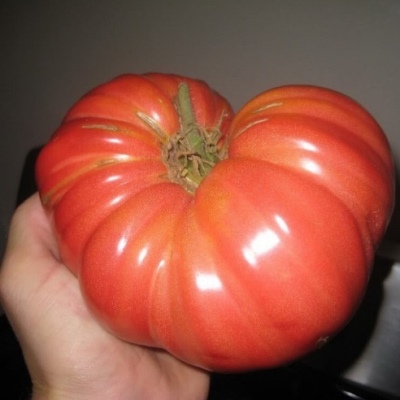
- Authors: Postnikova O.V.
- Year of approval: 2017
- Category: grade
- Growth type: determinant
- Appointment: fresh consumption
- Ripening period: mid-season
- Ripening time, days: 105-110
- Growing conditions: for open ground, for film greenhouses, for greenhouses
- Bush size: tall
- Bush height, cm: 150
Recently, breeders have been trying to bring out fruitful and tasty varieties that grow well in regions with a difficult climate and risky farming. Among the new products is the mid-season Siberian Shangi variety, which attracts the attention of both summer residents and farmers.
Breeding history
The Siberian shangi tomato is the result of the fruitful work of a group of domestic breeders under the leadership of O. V. Postnikova, representing the Siberian Garden agricultural company. The nightshade crop was brought out in 2015, and in 2017 the tomatoes were entered into the State Register of Breeding Achievements of Russia and allowed for use.
The variety is successfully cultivated in all regions of the country (Far East, Central, Nizhnevolzhsky, Uralsky, East Siberian, North-West, Volgo-Vyatsky, Central Black Earth). The high productivity of tomatoes was noted when grown in film greenhouses, however, in the southern and central strip, the tomato grows in the open field.
Description of the variety
Siberian shangi is a tall plant of a determinant type, growing in height up to 150 cm. When grown in greenhouse conditions, the plant stretches up to 170-180 cm. A powerful bush is characterized by medium thickening of green leaves, a strong central stem and branches, a developed root system that feeds the plant, and intermediate inflorescences. On a healthy bush, from 4 to 6 fruit clusters with 3-5 tomatoes on each are formed.
Growing tomatoes involves the formation of bushes in 1 stem, the regular removal of stepchildren, which appear quickly, as well as a garter to a support, since tomatoes are very weighty and can break off even a strong stem and branches. In addition, experienced gardeners recommend removing excess leaves by thinning the bush located below the first and second fruit cluster. Tomatoes have a salad purpose, so they are eaten fresh, used in cooking, and also processed into ketchup, pasta, and drinks.
The main qualities of the fruit
The Siberian Shangi tomato is a class of large-fruited varieties. The average weight of a berry is 157 grams, but in practice tomatoes grow up to 300-800 g. The vegetable is endowed with a flat-round shape with a weak surface ribbing, a beautiful raspberry color when ripe and a strong, shiny skin that is not felt when consumed. In an unripe form, tomatoes are light green in color, with a dark spot at the base. The berries are resistant to cracking, tolerate transportation well and are stored for a long time without loss of taste and marketability.
Taste characteristics
Tomatoes have a distinct taste. The flesh of the fruit is fleshy, medium-dense, very juicy and sugary. There are very few seeds in the pulp. The taste is dominated by dessert sweetness, complemented by a bright aroma. The taste of berries, their sugar content and sweetness directly depend on the climate of the region where the culture grows. With prolonged cold snaps, the tomato can acquire a slight sourness.
Ripening and fruiting
The culture belongs to the mid-season group. From the moment of mass germination of seedlings to ripe fruits on the brushes, 105-110 days pass. Tomatoes are grown gradually. You can taste sweet tomatoes already in July. The peak of fruiting occurs in July-August. The last tomatoes can be removed brown and allowed to ripen at room temperature.
Yield
The high yield is due to the large-fruited tomatoes. On average, 5.6 kg of berries are harvested from 1 m2.
The timing of planting seedlings and planting in the ground
Sowing seeds is carried out in March-April (60 days before transplanting). Seedlings are pre-sorted and disinfected. With the provision of heat (+ 22-24) and light (12-14 hours / day), germination will occur after 6-7 days. At the stage of the appearance of 2 leaves, you can plant the bushes in separate cups. 7-10 days before the transfer, the bushes should be hardened, which will allow them to quickly get used to the new place of growth. Transplanting seedlings is carried out in May-June.

Growing tomato seedlings is an extremely important process, because it largely depends on whether the gardener will be able to harvest at all. All aspects must be taken into account, from seedbed preparation to planting in the ground.
Landing scheme
Planting density and pattern are important when growing a crop. No more than 3 bushes can be planted per 1 m2. The optimal scheme for planting is considered to be 40x60 cm.

Growing and care
Loose and fertile soil is suitable for tomatoes. They grow well in places where carrots, cabbage or radishes used to grow. After planting, the plant must be provided with comprehensive care, consisting of watering, fertilizing, forming bushes, tying them to a support with synthetic materials, pinching, loosening and weeding the soil, protection from insects and fungus.




A plant needs different micronutrients at each stage of growth. All fertilizers can be divided into two groups: mineral and organic. Folk remedies are often used: iodine, yeast, bird droppings, eggshells.
It is important to observe the rate and period of feeding. This also applies to folk remedies and organic fertilizers.
Disease and pest resistance
High immunity protects tomatoes from many diseases - fusarium wilting, Alternaria and late blight.


Resistant to adverse weather conditions
Tomatoes are very hardy, so they can easily tolerate heat, temperature fluctuations and short drought.

























































































